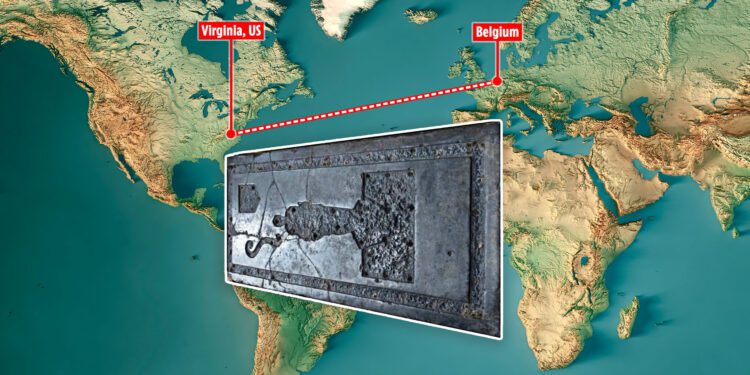2
Records show only two knights died in Jamestown, the first permanent English settlement in the Americas, during the 17th centuryCredit: Marcus Key et al International Journal of Historical Archaeolog
But they didn’t know who the knight was, or where he came from – until now.
Scientists believe the carved depression on the tomb likely held brass inlays of a shield, an unfurled scroll, and a depiction of an armoured man.
After analysing the carvings and historical records, archaeologists have uncovered the identity of the ancient knight who was laid to rest nearly 400 years ago.
Records show only two knights died in Jamestown, the first permanent English settlement in the Americas, during the 17th century – Sir Thomas West, in 1618, and Sir George Yeardley.
A tombstone ordered in the 1980s with the same inscription as the black limestone one was found to belong to Sir Yeardleyﻗs step-grandson.
This led researchers to believe that the 1627 tombstone belonged to Sir George Yeardley, a man born in Southwark, England, in 1588.
The English knight arrived at Jamestown in 1610 after surviving a shipwreck near Bermuda, and was knighted in 1617 when he returned to England by King James I.
Sir Yeardley eventually returned to Jamestown in 1621 and died there in 1627.
What happens to your body when you die?
These are the processes that the human body goes through when its no longer alive…
Immediately after death, all of the muscles in the human body relax into a state calledﺡ primary flaccidity, which can result in open eyelids, dilated pupils and floppy limbsWhen the heart has stopped beating for a few minutes, blood starts to drain from the smaller veins in the skin and the body can look palerThe body temperature also starts to decrease slowly, starting with two degrees in the first hour and one degree less there afterLivor mortis occurs when the blood drains to parts of the body closest to the ground and creates bruises sometimes referred to as the ﻗpostmortem stainﻗIn approximately the third hour after death, rigor mortis sets in and all the body muscles stiffen into the position they are inLimestone mystery
Where the black limestone that was used for the funerary marker came from has also been a mystery.
But after assessing stone fragments from the tombstone, scientists were able to trace the stone’s origins to Belgium.
The rock contained a combination of fossil microbes that could not have all originated from North America.
The particular combination of microbes meant the stone could have only been dug up from Belgium or Ireland – a choice that was eventually narrowed down to Belgium, which was an avid exporter of this type of limestone at the time.
Successful Virginia colonists who had lived in London would have been familiar with the latest English fashions and tried to replicate these in the colonies.
ﻗWe hypothesise it was quarried and cut to size in Belgium, shipped down the Meuse River, across the English Channel to London where it was carved and the brass inlays installed, and finally shipped on to Jamestown,” scientists wrote.
The black limestone was “in-demand and expensive” at the time, according to researchers.
ﻗSuccessful Virginia colonists who had lived in London would have been familiar with the latest English fashions and tried to replicate these in the colonies,ﻗ they added.
The findings not only shed more light on the extensive trade networks connecting Europe to Jamestown in the colonial era.
The study also highlights the effort settlers went to to commemorate themselves at a time that was defined by hunger, disease and warfare with Native Americans.
Strange UK burials sites
Here are some of the weirdest…
Leicester car park: King Richard IIIﻗs remains
In 2012, King Richard IIIﻗs skeleton was famously found under a Leicester car park.The corpse had a metal arrow in its back and severe trauma to its skull.The following February, lead archaeologist Richard Buckley, of the University of Leicester, said tests proved the remains were the kingﻗs ﻗbeyond reasonable doubtﻗ.Richard was killed in the Battle of Bosworth Field in 1485.His demise was dramatised by Shakespeare, who had the monarch calling out ﻗa horse, a horse, my kingdom for a horseﻗ before he died on battlefield.
Dartmoor: Grave of ﻗBronze Age princessﻗ
Its beautiful moor attracts hundreds of thousands of visitors every year, but in 2011, remains thought to belong to a Bronze Age princess were discovered on Dartmoor.The bones ﻗ thought to date back over 4,000 years ﻗ were found in a peat bog on White Horse Hill alongside a number of remarkable items, including around 150 beads, an animal pelt, a delicate bracelet and a woven bag.The picturesque National Parkﻗs archaeologists were stunned to uncover the grave, which was described at the time as one of the most significant historical finds ever at the site.It is speculated that the grave was that of a young, royal woman.
Rare Oxfordshire stream: 26 human skeletons
A beautiful stream in Oxfordshire might look like an unlikely place to find 26 human skeletons ﻗ but thatﻗs what happened recently near the precious Letcombe Brook.The skeletons, believed to be from the Iron Age and Roman periods, were discovered during a ﺡ۲14.5 million Thames Water project to ease pressure on the rare chalk stream.Archaeologists believe some may have been victims of ritual human sacrifice.The skeletons are thought to be about 3,000 years old.Evidence of dwellings, animal carcasses and household items, including pottery, cutting implements and a decorative comb, were also unearthed.Cotswold Archaeology removed the items for forensic examination, which meant Thames Water could start laying the six-kilometre pipe.
Source link : http://www.bing.com/news/apiclick.aspx?ref=FexRss&aid=&tid=66ec21f826fa411083787d320c6e6b83&url=https%3A%2F%2Fwww.thesun.ie%2Ftech%2F13845290%2Famerica-us-oldest-tombstone-english-knight%2F&c=9618686492005913102&mkt=en-us
Author :
Publish date : 2024-09-19 00:15:00
Copyright for syndicated content belongs to the linked Source.












